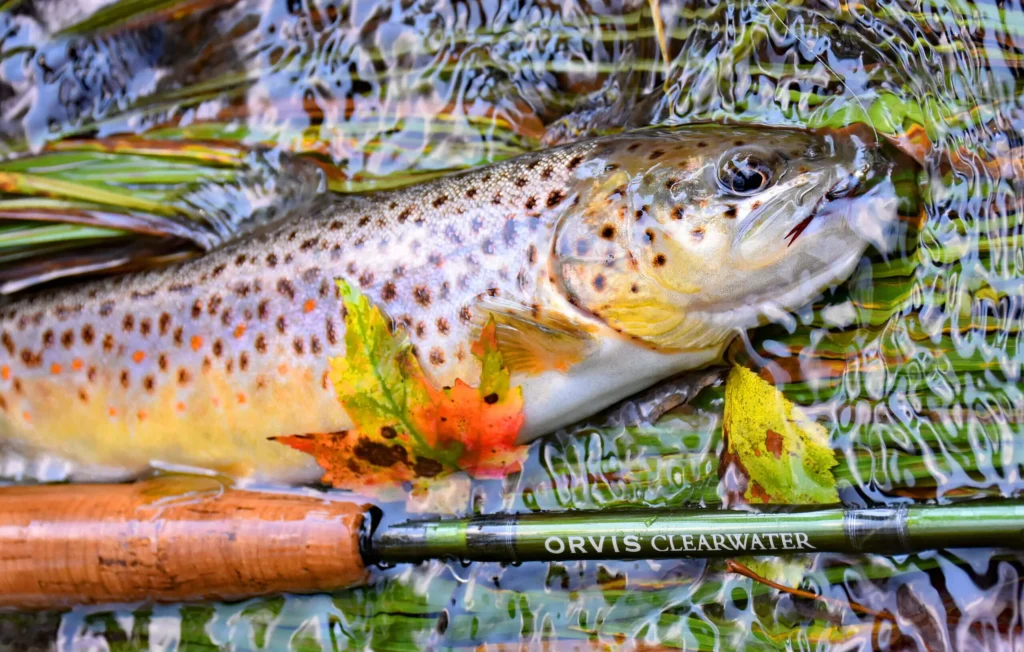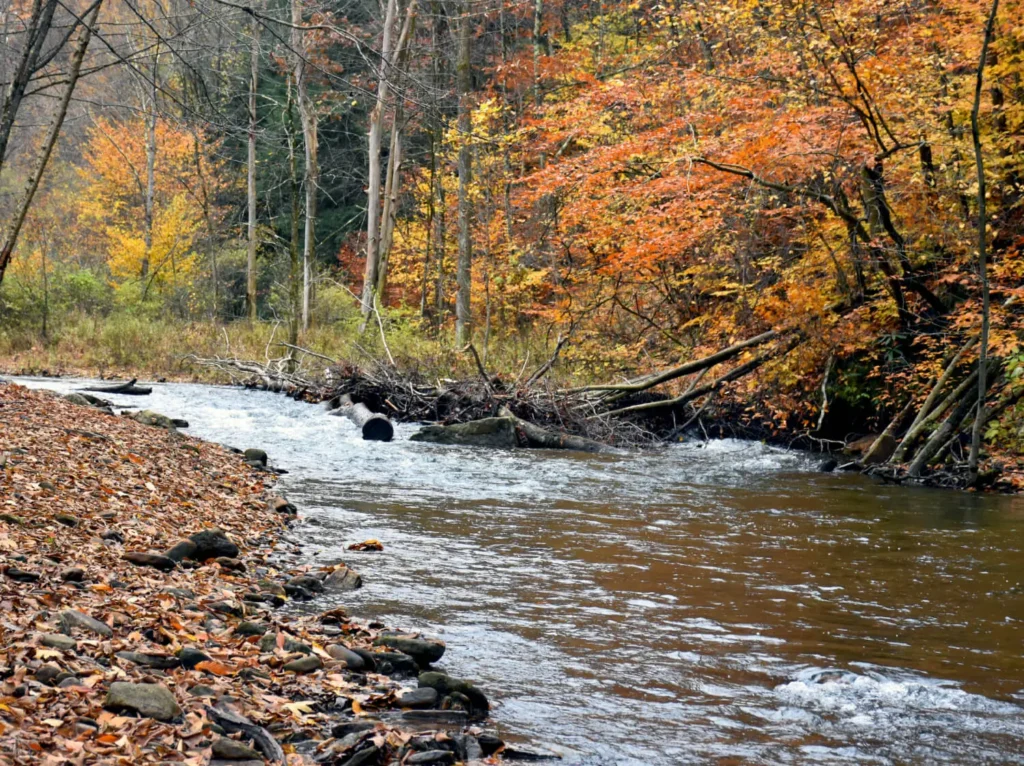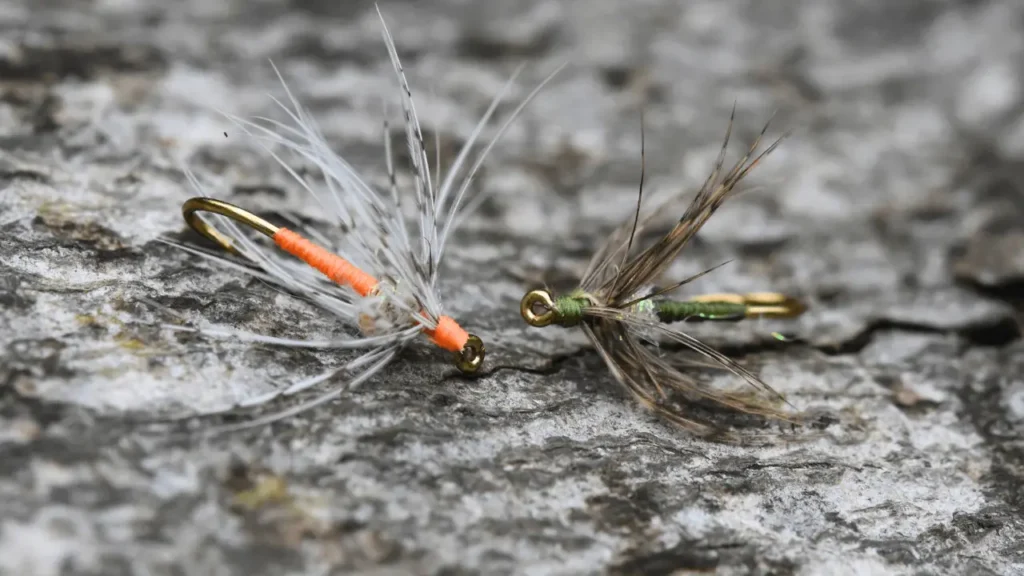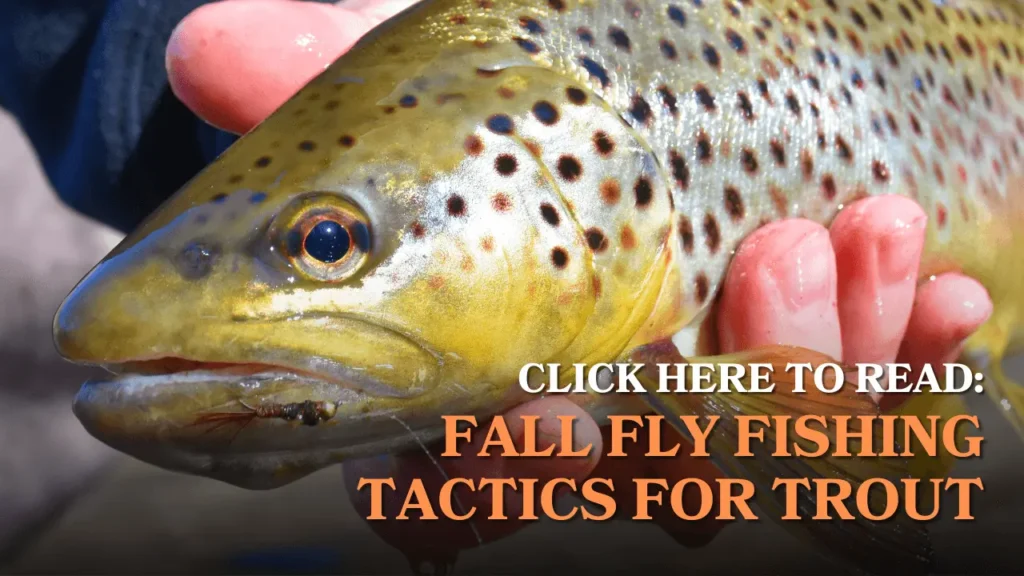Best Flies for Fall Fly Fishing for Trout

One of the joys of fly fishing, for me, is filling my box with a variety of patterns that I just know will catch fish. There’s a difference, though, in just filling a box with great flies and being intentional with how you build your fly box, particularly from season to season. Hatches change, water conditions change, and sometimes new opportunities arise. The best flies for spring trout are not necessarily the best flies for fall fly fishing. For this reason, as fall approaches, I do an inventory of my fly box, pulling out some patterns while adding new ones, so that I can be prepared next time I’m on the water.
Everyone has their favorite patterns, and there are indeed patterns that catch trout year round. But the following handful of flies are ones that I make sure to have plenty of in my fly box when the leaves start to change color, water temperatures drop, and my favorite streams become fishable again.
As with fishing any time of year, this selection includes a variety of dry flies, soft hackles, nymphs, and streamers. In truth, this list could be three or four times longer than this, mainly due to the fact that every angler has their own batch of confidence flies that work well for them. However, the flies on this list each serve a specific purpose and fill a niche in my fall fly fishing arsenal.

Best Dry Flies for Fall Fly Fishing
Baetis Emerger Cripple
Some of the best fall hatches I’ve ever experienced were Baetis hatches. For fishing this hatch, the Baetis Emerger Cripple is my first choice. I use this one is sizes 16-22.
Baetis is a genus of mayflies that include Blue Wing Olives. There are at least 150 known species of Baetis distributed worldwide. They’re prolific insects, too, often producing multiple broods. Most Baetis are small – in fact, if most anglers see fish rising but can’t actually see any insects in the air, they usually assume those trout are feeding on some type of Baetis. These insects go by various names (Blue Wing Olives, Olive Quills, Little Blue Wing Olives, etc) and commonly range from size 16 down to 22…and smaller.
Although they are strong swimmers, their diminutive size makes it difficult for them to break surface tension, which is typically highest on cooler days when these insects prefer to emerge. Therefore, they often get trapped in the surface film as they struggle free of their shucks and become sitting targets for hungry trout. This is why the Baetis Emerger Cripple is the first on my list of flies for fall fly fishing.
Elk Hair Caddis
Caddis are also found on most streams and rivers across the country, and often in abundance. The Elk Hair Caddis is a Pennsylvania pattern, developed by Al Troth in 1957 to fish the tumbling waters of Loyalsock Creek. This is a high-floating pattern that performs well on small brooks and large rivers alike.
Here in Pennsylvania, we see quite a few October Caddis, which have an orangish belly and large, darker Grannom-like wings. For that reason, I tie my Elk Hair Caddis in a variety of colors. For fall fly fishing, using an orange or burnt orange dubbing for the body will perform well. Two other colors that I always have on hand are brown and olive/green. I tie the October Caddis version of the Elk Hair Caddis in sizes 10 and 12 and the brown and olive/green versions in sizes 14 and 16.
Also, don’t be afraid to prospect with the Elk Hair Caddis. Because caddis are found on so many streams and rivers worldwide, trout are used to seeing them, and they’re likely to take a well-presented Elk Hair Caddis any time of day.
Stimulators
The Stimulator is a great fall pattern. The orange-bodied Stimulator can be a great stand-in for the October Caddis, and it catches fish practically year round. Another great fall version of the Stimulator is tied with a black body, especially on years when gypsy moths are abundant. Many of these worm-like creatures fall into the water and trout will station under overhanging branches and gorge on them.
Fishing large flies such as Stimulators and Hoppers (which are next on my list of best flies for fall fly fishing) can be a ton of fun. However, they do present a few problems. Big, wind-resistant flies can cause an absurd amount of twisting in your leader and tippet. Here’s an article you will hopefully find helpful for fishing big flies more effectively: Read “Stimulators and Hoppers, the Art of Fishing Big Dry Flies.”
Hoppers
Hopper patterns come in a variety of shapes and styles, from the deer hair Letort Hopper to the realistic J:Son Flies hopper. Any of them work in various situations. For fast water, though, I have found that more “imitative” versions, such as the Letort Hopper, work best. For flatter, slower-moving water, realistic versions are my first choice.
Many folks, myself included, fish a “hopper-dropper” rig in the fall. Because hoppers are so big and buoyant, they’re great for dropping a nymph off the bend of the hook. There are two advantages to using a hopper as an indicator for fall fly fishing. First, the water is usually low and clear, which means fish can be spooky; a hopper pattern appears more natural than a plastic, brightly-colored strike indicator. Second, trout (and bass) love hoppers, so you’re essentially increasing your chances of success when using them as an indicator.
This article discusses the hopper-dropper rig more in-depth as well as provides some insights on how to choose the best hopper for the situation: Read “Hoppers and Droppers, Oh My!”
Parachute Adams
Any “best flies” list would be remiss to not include the Parachute Adams. This general, all purpose pattern imitates a plethora of insects, and any fly that has the potential to match a plethora of hatches has a place in my fly box year round. I use sizes 12 and 14 when I’m looking for a Slate Drake option or a fly buoyant enough to use in a dry-dropper rig. In size 20 and smaller it’s a great option when you encounter a fall Baetis hatch.
Best Soft Hackle Flies for Fall Fly Fishing

Partridge and Orange
You don’t often see soft hackle flies on “best flies” lists for any season, let alone for fall fly fishing. Soft hackles seem to fall in and out of vogue, and in truth, they may be more popular with fly tiers than fly fishers. They’re classic patterns that can be traced back to the root of fly fishing itself. In recent years, I’ve begun adding more of these patterns to my fly box for one simple reason: centuries later, they still work.
The Partridge and Orange can imitate a number of insects, but the reason I believe it belongs in every box for fall fly fishing is because of the October Caddis, which, as mentioned, also has an orange body. Caddis hatches, in general, are notoriously frustrating for anglers because they don’t always spark the surface feeding one would expect. In fact, most of the feeding takes place below the surface, and often in the middle of the water column. No matter how you fish the Partridge and Orange, it will catch fish in the fall. Dead-drift it like a nymph, swing it down and across, or even grease it up with floatant for those specialized situations where you find trout taking emergers in those soft back eddies on larger waters. Carry this pattern in sizes 12-16.
Partridge and Olive
Given everything you just read about the Partridge and Orange (and earlier about Baetis), you can probably figure out why the Partridge and Olive is on this list, too. The Partridge and Olive is a great BWO imitation. Use before, during, and after hatches. As with the Partridge and Orange, I fish the Partridge and Olive in every water column, even on the surface in specialized situations. Carry this pattern in sizes 16-20.
Tip: When fishing soft hackles on the surface, use a powder shake or desiccant style of floatant. This will work best on the partridge and hen hackles typically used to tie soft hackle flies. For more about which floatants work best in certain situations, check out this article: “Is There Really One Dry Fly Floatant to Rule Them All?”
Are You Enjoying This Article?
Stay up to date with the FREE Dark Skies Fly Fishing newsletter delivered three times per month to your inbox. Your information is never sold or shared to any third party and is used solely for the purpose of keeping you updated and informed about the latest news, tricks, tips, stream reports, and new releases from Dark Skies Fly Fishing.
Sign Up NowBest Nymphs for Fall Fly Fishing
Green Weenie
Wild brown trout love the Green Weenie! Come late summer/early fall, it’s almost mandatory to have a selection of Green Weenies in the fly box. This is another Pennsylvania pattern, originally developed to fish Loyalhanna Creek in Westmoreland County, that has become well-known for catching trout worldwide.
The Green Weenie is perhaps the easiest fly you’ll ever tie. It’s little more than Ultra Chenille wrapped around the hook shank. Here’s a quick video on how to tie it, and if you want to read more about the history of this simple little pattern, read this article. I tie the Green Weenie with a tail when fishing it on an indicator rig and without a tail when tying and fishing it Euro nymph style.
Guide’s Choice Hare’s Ear
For fall fly fishing, I tend to favor patterns that have what G.E.M. Skues referred to as “kick” in his 1921 book, The Way of the Trout with the Fly. This revolutionary work introduced this concept as it applies to flies with built-in movement, without which flies would simply look dead. The Guide’s Choice Hare’s Ear, and other patterns mentioned in this article, have plenty of kick, and will produce trout when others do not. Hence, the name of this pattern includes the words “Guide’s Choice.”
The Guide’s Choice Hare’s Ear is a very buggy nymph typically tied with a tungsten bead, and it can imitate a number of insects. Similar to the traditional Hare’s Ear Nymph, it has a general, attractor quality that make it indispensable for fall fly fishing. I carry this one in sizes 14-18, natural color and olive.
Blow Torch
The Blow Torch, developed by competitive fly angler Devin Olsen, is one of the best all around nymphs for fall through spring here in the Eastern United States. It has great movement and a couple of key hot spots that trigger strikes. For many years, I resisted adding this pattern to my fly box. I’m not even sure why. Maybe because it’s so popular, and part of me always seems to want to steer away from the direction everyone else is going? Whatever the reason, I finally came around and quickly learned how well this pattern produces fish when nothing else will.
When water levels are up and slightly off color, I fish the Blow Torch in a size 12. As levels drop and water clears, I drop down to a size 14 or 16 version of this pattern. Also, I prefer to tie this one with a little sparser tail than most, as you’ll see in the video I recently completed about how to tie the Blow Torch.
Beadhead Black Hare’s Ear Nymph
Black has always been a great color for fall fly fishing, and the Hare’s Ear Nymph is a great, general nymph pattern, so it makes sense that a Black Hare’s Ear Nymph would make my list of best flies for fall fly fishing. I’ve caught a lot of trout on this pattern in the fall! I stock this one in sizes 16-18.
Zebra Midge
I tie the Zebra Midge in a variety of colors that I use year round: black, olive, red, and purple. They all produce trout, especially in the fall and winter, which is why you’ll also find this pattern on my “Top 10 Flies for Winter Fly Fishing” article also available on this website.
Fall and winter hatches typically consist of smaller insects and midges. Tied in sizes 16-22, the Zebra Midge can imitate any of these. Although I carry size 16s, I rarely use them. I’ve found that size 20 seems to be the sweet spot for the Zebra Midge on most waters I fish, so if space is limited in your fly box, I’d recommend that size. And if I had to choose only one color to stock for fall fly fishing, black would be my first choice, followed closely by purple.
Beadhead Prince Nymph
The Prince Nymph is another classic fly pattern that makes my list of best flies to use for fall fly fishing. This general attractor pattern can represent any type of mayfly, but it’s mostly thought of as a stonefly imitation. Regardless what we think it imitates, the trout all seem to agree that it looks like food.
The two most common sizes of Prince Nymphs that I use are size 12 and size 18. I typically tie the size 12 on a 2xl nymph hook, which results in a longer-bodied nymph that definitely takes it into the realm of stonefly. The size 18 I tie on a standard-length nymph hook, which I believe lands it more into the realm of emerger.
If you’re looking for an interesting variation of the Prince Nymph, check out the “Fly Formerly Known as Prince.” The FFKAP is a flashier alternative that induces strikes in colder water when fish are sluggish.
Best Streamers for Fall Fly Fishing
Muddler Minnow
The Muddler Minnow was invented in 1936 by Don Gapen of Anoka, Minnesota, and is a great imitation for all types of sculpin, baitfish, and other forage. I typically have a selection of Muddler Minnows in sizes 6-12. The larger sizes are great for stripping or swinging, and I often dead drift the smaller ones. Also, a size 12 has approximately the same profile as a hopper, and can be fished on the surface in a pinch.
The Muddler Minnow’s real effectiveness for fall fly fishing, though, relies on its ability to imitate baitfish. I most commonly use a strip-retrieve with various pauses and movement throughout the retrieve to imitate skittish baitfish, wounded minnows, and other prey that brown trout key on during the pre-spawn of early fall. Fish this time of year feed much more aggressively in preparation for the spawn and for winter, so don’t be afraid to fish this fly fast.

Beadhead Woolly Bugger
Any list of flies I conjure would be incomplete without a Beadhead Woolly Bugger. When fishing small to mid-sized streams here in the Eastern U.S., Beadhead Woolly Buggers in sizes 6-12 are ideal, and my favorite fall colors are black and olive.
Part of what makes the Beadhead Woolly Bugger a necessity for any fly box, is because of its versatility. Swing it, dead drift it, strip it…all techniques will catch fish. Also, they’re perfectly-sized for most trout streams here, where fish might range 10-14 inches – and they offer a hearty enough meal for larger trout to want to eat, too.
Mini Dungeon
On the bigger rivers of the Western U.S., large, articulated streamers are the rage for targeting huge trout in the fall, and the Sex Dungeon is a great choice. Our rivers in the East aren’t nearly as big or powerful, and the trout aren’t nearly as aggressive (in my experience), but the Mini Dungeon, which is a scaled-down version of the Sex Dungeon, works quite well on big, local brown trout. I think this pattern is ideal for waters in the Eastern U.S. when it’s tied in the 3-5-inch range.
There are other benefits for using the Mini Dungeon, too. First, it’s easier to cast than the full-sized version. Second, it’s not exclusively a big fish fly, and you’ll occasionally take trout in the 14-16-inch range as well as smallmouth bass of all sizes. In fact, I’ve caught some very nice smallmouths on this fly while fishing it slow and deep in the big pools where bass tend to congregate when water temperatures start to drop.
However, if my goal was to catch the biggest, baddest brown trout in the river this fall, my number one choice would be a Mini Dungeon. Black, white, and crawfish orange have all produced some very fine fish for me during the fall months.
What Flies are in Your Box for Fall Fly Fishing?
So there you have it, my top 15 flies for fall fly fishing. These are the patterns that work best for me this time of year. Each one has been curated to fill specific niches in my arsenal, from working over a stretch of finicky trout sipping on Baetis to targeting aggressive, hungry browns fattening up for the spawn and winter.
What flies are your “must haves” for fall fly fishing? Please leave a comment below and let us know what you think of our list, what you’d add or subtract, and what works best in your part of the country. Tight lines!
Did You Enjoy This Article?
Stay up to date with the FREE Dark Skies Fly Fishing newsletter delivered three times per month to your inbox. Your information is never sold or shared to any third party and is used solely for the purpose of keeping you updated and informed about the latest news, tricks, tips, stream reports, and new releases from Dark Skies Fly Fishing.
Sign Up NowLooking to take your fishing to the next level?
Book a day on the water where we can show you how to read the water, make better presentations, catch more fish, and enjoy time spent outdoors more than ever before.
Book Now!

Do you have e a rescipe for a black mini dungeon?
Hi Russ, Here’s a YouTube tutorial by Kelly Galloup, the guy who invented the Mini Dungeon. He does a great job in this video explaining step by step how to tie this fly. Also, he sells kits that have everything you need in them to tie specific colors of Mini Dungeons. I believe they’re around $35-40 and you get enough materials to tie about a dozen of them.
https://youtu.be/EvL-gJ4vWFI?si=8ajyqWIPTxXD1fHA
Hi Ralph.
I really like your Fall fly selection and would not remove any from your list. But I don’t think I could leave an ant pattern out of my dry fly selection. I prefer a parachute style so I can see it better.
Also, thanks for throwing some love to the Muddler Minnow. That was I fly I grew up with fishing in the 1970s and I got away from it once the woolly bugger showed up. I tied a muddler on this summer for the first time in forever, and it caught my biggest trout of the year! It’s back as a favorite of mine again, and shouldn’t have left my list of confidence flies in the first place.
Tim D
Hi Tim,
You make a great point…an ant pattern definitely deserves to be on this list! Not sure how I missed that one. I have an article I did right before this one that’s all about ants, though. Hope you’ll check that one out (https://darkskiesflyfishing.com/post/how-to-fish-and-tie-flying-ant-and-fur-ant-patterns-and-when-to-fish-them/). I, too, like the parachute style, especially on limestone streams like the Letort and Big Spring.
The Muddler is an oldie but goodie! Glad to hear it’s still producing for you, too! Best of luck on the water this fall, and thank you for taking the time to share your thoughts on this article.
Ralph